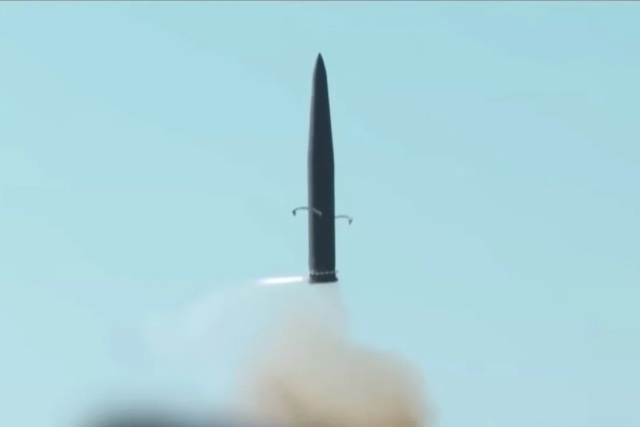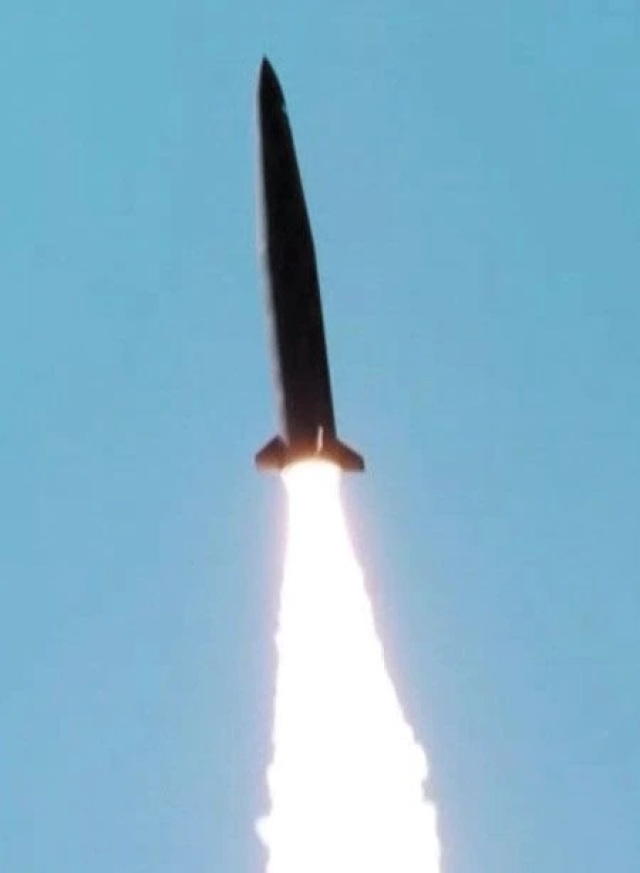In the official video distributed by the Ministry of National Defense of South Korea on October 1, 2022, dedicated to the traditionally celebrated October 1 Day of the Armed Forces of South Korea, a new and previously unknown South Korean Hyunmoo 5 (V) ballistic missile "with the largest warhead in the world" was shown for the first time. The mass of the warhead of the Hyunmoo 5 rocket, according to South Korean media. allegedly, it can be from 8 to 9 tons.

The new South Korean Hyunmoo 5 ballistic missile during the launch using the "cold start" technology (c) a frame from the video of the Ministry of National Defense of South Korea It is also reported that the Hyunmoo 5 has a flight range of more than 3,000 (according to other sources, 3,500) kilometers in a variant with a lighter warhead "weighing less than one ton", and thus is the first South Korean medium-range ballistic missile.
The range of the missile in the version with a heavy warhead (allegedly from 8 to 9 tons) is not officially disclosed, but according to South Korean media is 300 km. It is estimated that the Hyunmoo 5 rocket has a length of 15-16 m and a body diameter of 1.6 m. The rocket is solid-fuel.
An unnamed source in the South Korean government said on October 2 that "the Hyunmoo 5 missile was shown, which has improved characteristics in terms of the weight of the warhead and other things compared to the previous Hyunmoo 4 missile."
A characteristic feature of the Hyunmoo 5 rocket, judging by the video, is the use of "cold start" technology on it, with the engine starting at an altitude of about 30 m. All previous South Korean Hyunmoo series rockets use a "hot start". The Hyunmoo 5 rocket launcher is not shown in the video, but judging by the launch footage, it seems to be made on a trailer towed by a tractor.
The purpose of the Hyunmoo 5 missile is to defeat protected command centers and protected missile launchers of the DPRK. The missile was developed within the framework of the concept of the "Korean Massive Punishment and Retaliation plan" (KMPR: Korea Massive Punishment & Retaliation plan), which is one of the "axes" of Seoul's recently proclaimed "three-axis" strategy directed against the DPRK. The other two "axes" of this strategy include the Kill Chain preemptive strike intelligence and strike platform and South Korea's Integrated Layered Air and Missile Defense System (KAMD).
Recall that South Korean missile development for a long time was kept under strict contractual control of the United States, which for political reasons prevented the creation of missiles of considerable firing range in South Korea. The first US-South Korean agreement on this subject was signed in 1979, then modified agreements were concluded in 1990 and 1997. Initially, the first agreement of the 1979 Missile Development Guideline gave the South Korean side the right to develop ballistic missiles with a flight range of only up to 180 km and a warhead weight of up to 500 kg. The last Missile Development Guideline agreement of 1997 gave South Korea the right to develop ballistic missiles with a range of up to 300 km with the same maximum warhead weight of up to 500 kg, which was secured by South Korea's accession to the Missile Technology Control Regime (MTCR) in 2001.
In 2012, the American side signed amendments to the missile development agreement with South Korea, which gave South Korea the opportunity to create ballistic missiles with a range of up to 300 km and a warhead weight increased to 2000 kg, as well as with a range of up to 500 km and a warhead weight of up to 1000 kg and with a range of up to 800 km and a weight of warhead up to 500 kg. With the new revision of the missile development agreement in 2017, South Korea was able to increase the mass of the warhead of missiles with a range of 800 km from the previously permitted 500 kg to 2000 kg. South Korea immediately took advantage of the achieved permissions by developing and testing a series of operational-tactical and "shorter-range" Hyunmoo 2/4 ballistic missiles with increasingly increasing characteristics.
Also, the 1997 agreement prevented the creation of large-sized solid-fuel rocket engines in South Korea that could be used to develop long-range combat missiles, but in July 2020, the United States agreed to another revision of the agreement, allowing South Korea to create space launch vehicles on solid fuel. Finally, in May 2021, US Presidents Joe Biden and South Korea's Moon Jae-in during a meeting in Washington html" target="_blank" rel="nofollow">reached an agreement on the lifting by the United States of all restrictions on the range of South Korean ballistic missiles. The joint statement signed by the heads of both states also announced the termination of the US-South Korean missile Development Agreement of 1997, and thus South Korea gained the ability to create ballistic missiles of almost any class.
Missile development was started in South Korea back in 1958, and in the early 1960s, the first tests of experimental tactical missiles were conducted. In the 1970s and 1980s, South Korea actually secretly developed the first South Korean operational-tactical ballistic missile Hyunmoo 1 with a firing range of about 180 km, based on the old American Nike Hercules anti-aircraft missile, which was "legalized" only by an agreement with the United States in 1990. After the conclusion of the 1997 agreement in South Korea, an operational-tactical solid-fuel ballistic missile Hyunmoo 2 (now designated Hyunmoo 2A) with a range of up to 300 km and a warhead weight of up to 500 kg was developed under the auspices of the Defense Development Agency (Agency for Defense Development - ADD) of the Ministry of National Defense of South Korea, which entered service in 2011 year.
After the revision of the missile development agreement in 2012, South Korea immediately began developing missiles with appropriate parameters. In 2015, the first test of a missile, designated in open sources as Hyunmoo 2B, with a firing range of 500 km and a warhead weight of 1000 kg, was carried out, and in April 2017, a missile, designated in open sources as Hyunmoo 2C, with a firing range of 800 km and a warhead weight of 500 kg was tested. After the last revision of the missile development agreement in 2017, in April 2020, the first successful test launch of the Hyunmoo 4 ballistic missile was carried out, which is considered to be the development of the Hyunmoo 2C ballistic missile with a maximum range of up to 800 km, but with an increase in the weight of the warhead from 500 kg to 2000 kg (the warhead penetrating type). According to more recent data, a variant of the Hyunmoo 4 missile (possibly Hyunmoo 4-1) with a range of up to 500 km and a penetrating warhead weight of 4000 kg has also been created. In July 2021, a variant of the Hyunmoo 4-4 (K-SLBM) underwater launch rocket was also tested for the first time for launching from submarines.
Hyunmoo ballistic missiles are created with the participation of a broad cooperation of South Korean defense companies led by Hanwha Corporation, which is their direct serial manufacturer.

The new South Korean Hyunmoo 5 ballistic missile during launch after dropping the tail guard and opening the control surfaces (c) a frame from the video of the Ministry of National Defense of South Korea Video (Hyunmoo 5 missile is shown from 00:44) (c) Ministry of National Defense of South Korea :
